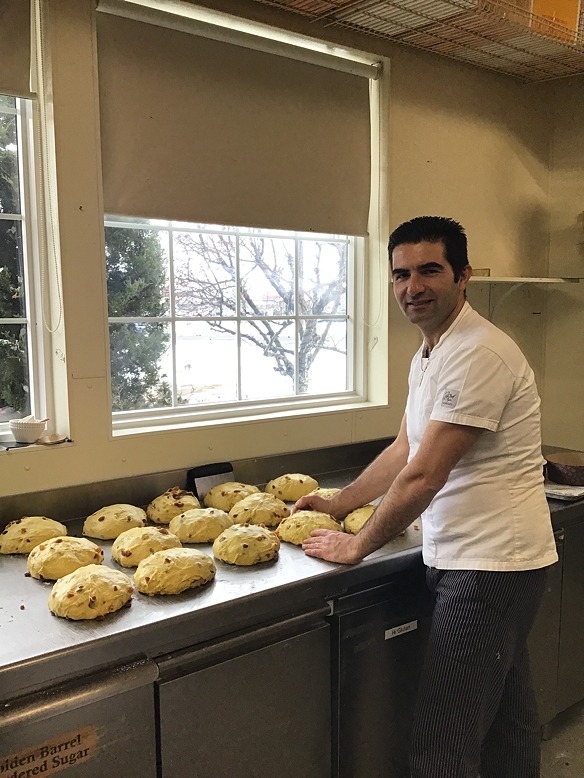
“Palazzone 1960” might sound like any other Italian bakery, but the name is actually a mini family history: owner Giancarlo Palazzone named the Wayne bakery after his parents, Remo and Julia, Italian immigrants who’d come to the U.S. and opened a bakery in Clifton in 1960. Remo and Julia eventually returned to Italy to raise their kids, but when their son Giancarlo returned to the United States in 2012—called here, as he tells it, since he was a little boy—he decided to name the second family bakery in honor of the first.
Whatever it’s called, we’re lucky it’s here, especially this time of year: not only does Palazzone do a solid year-long business, they specialize in that ubiquitous (if misunderstood) Italian Christmas treat: panettone, a Milanese leavened Italian Christmas bread studded with raisins and candied citrus. Giancarlo carries on his family’s Italian tradition, cranking out the panettone every year starting in November. And his panettone is good—light, subtly rich, not too sweet.
We caught up with the Giancarlo, who worked Thanksgiving and will be open on Christmas Day, to find out more about the seasonal magic of panettone at Palazzone 1960.

Giancarlo with a batch of his panettone in progress. Photo courtesy of Palazzone 1960
Table Hopping: You’re not the first Palazzone bakery owner in the States, correct?
Giancarlo Palazzone: Yes, Remo and Julia Palazzone opened in Clifton in 1960. He opened the first bakery in Clifton. My father is from Abruzzo and my mother [is] from the Amalfi Coast, in Campagna. They came back to Italy after 12 years or so. They first went to the Amalfi Coast, opened a restaurant in that area, and then to Abruzzo, where we still have a factory they started, where we make Panettone, candy, confetti, chocolate, pastry. I was born in Italy in 1975.
TH: But the rest of your family is still back in Italy. Why did you want to come to America?
GP: For me, it was always a dream to come back to America. Every year, we went [to America] to visit my grandfather, who was there, and I thought “One day, I want to go to America!”… We have a business in Italy already, but I decided maybe 10 years ago, with my wife, to come here finally. My idea was to come here and make something that’s really Italian, really authentic, with good ingredients.
TH: You do all the baking at Palazzone 1960. Where did you learn to bake?
GP: I grew up in my father’s businesses, but also I studied marketing and economics in college. And I was always taking some courses from a chef or baker. But really I was born into the business. When I was maybe nine or 10 years old, that’s when I first tried to cook, first tried to bake something.
TH: What makes your panettone special?
GP: It’s traditional, but it’s also very, very good because we use fresh ingredients. The key is really good ingredients. That means a good mother, good fresh egg yolks, good flour from Italy. We also use raisins, Madagascar vanilla, and orange peel from Sicily.
TH: Do Italians really eat panettone at Christmas?
GP: In Italy, it’s tradition: every Christmas, everybody eats panettone. It’s like turkey at Thanksgiving. The classic is the most popular. But we do chestnut, chocolate, sometimes we flavor with pistachio or cherry. But the classic is the most popular.
TH: I didn’t realize before this that panettone is made with a “mother,” basically a pre-fermented dough. Is it a long process?
GP: It’s very important to know: to make panettone, you need time. You need to make three different proofs in two days. Basically you need to make three different doughs in two days. It needs at least twelve hours yeast to proof. So for one panettone, the process for panettone takes almost three days.
TH: I’ve seen photos of freshly-baked panettone hanging upside down. Why is that step necessary?
GP: When you take panettone out from the oven, it’s warm. You need to put it upside down and wait 12 hours. You don’t want it to collapse on itself or flatten. Hanging it keeps the shape, keeps it light.
TH: I saw you offer a vegan panettone. So it’s not just classic or bust?
GP: Oh yes, we make panettone with gelato, panettone with fresh Chantilly cream. We make vegan panettone, yes. For that we just use extra virgin olive oil and no butter and no egg yolks. It’s a little different texture, but it’s very good.
TH: What other Italian desserts should we check out for Christmas?
GP: We also make in Christmastime the Struffoli. We make what we call “Tronchetto di Natale,” the roll with fresh cream inside. Also we make the Pandoro. It’s like panettone, but without raisin, without orange peel. It’s plain, though we can also make it with tiramisu filling. And we make other cakes, Italian cakes, that are typical for Christmas.
TH: Do you make panettone after the holidays?
GP: We make panettone in November and December only, because after, we have another big holiday, Easter, and for Easter we make Colomba. It’s similar to panettone, a different form but the dough is the same. We start again in February, making the Colomba for Easter. So panettone special for Christmas.
TH: What is your panettone production like? Is it more or less popular this year?
GP: We’re increasing the number of panettone we make every year. This year we’re making a lot, maybe 10,000 total. Also we have an order from a very famous company, Gucci. They asked us to send panettone to all Gucci stores and offices in America and Canada. Maybe with the Gucci order, we’re making more than 10,000 panettone, actually!
TH: If we can’t make it to your bakery, can we still get Palazzone panettone?
GP: Yes, we also sell online…Also in Hoboken, there is a place Dolce & Salato.
You can order Palazzone 1960’s panettone online or pick it up in the store if you’re in the Wayne area. Palazzone 1960, 190 Route 23 South, Wayne; 973-256-2734



